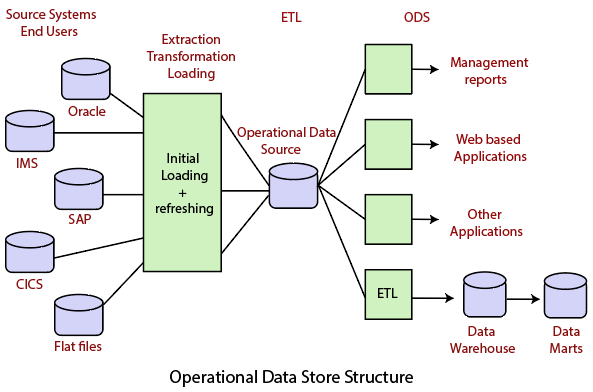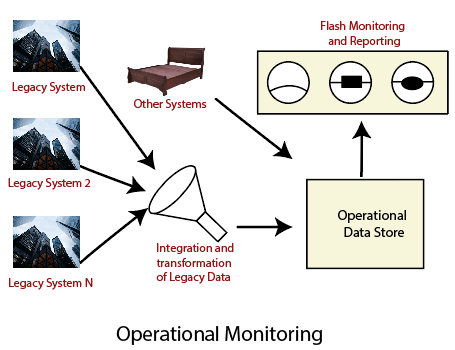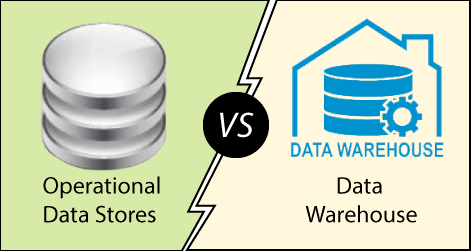What is Operational Data Stores?An ODS has been described by Inmon and Imhoff (1996) as a subject-oriented, integrated, volatile, current valued data store, containing only detailed corporate data. A data warehouse is a documenting database that includes associatively recent as well as historical information and may also include aggregate data. The ODS is a subject-oriented. It is organized around the significant information subject of an enterprise. In a university, the subjects may be students, lecturers and courses while in the company the subjects might be users, salespersons and products. The ODS is an integrated. That is, it is a group of subject-oriented record from a variety of systems to provides an enterprise-wide view of the information. The ODS is a current-valued. That is, an ODS is up-to-date and follow the current status of the data. An ODS does not contain historical information. Since the OLTP system data is changing all the time, data from underlying sources refresh the ODS as generally and frequently as possible. The ODS is volatile. That is, the data in the ODS frequently changes as new data refreshes the ODS. The ODS is a detailed. That is, ODS is detailed enough to serve the need of the operational management staff in the enterprise. The granularity of the information in the ODS does not have to be precisely the same as in the source OLTP system. ODS Design and ImplementationThe extraction of data from source databases needs to be efficient, and the quality of records needs to be maintained. Since the data is refreshed generally and frequently, suitable checks are required to ensure the quality of data after each refresh. An ODS is a read-only database other than regular refreshing by the OLTP systems. Customer should not be allowed to update ODS information. Populating an ODS contains an acquisition phase of extracting, transforming and loading information from OLTP source systems. This procedure is ETL. Completing populating the database, analyze for anomalies and testing for performance are essential before an ODS system can go online. 
Flash Monitoring and Reporting ToolsFlash monitoring and the reporting tools are like a dashboard that support meaningful online data on the operational status of the enterprise. This method is achieved by the use of ODS data as inputs to the flash monitoring and reporting tools, to provide business users with a refreshed continuously, enterprise-wide view of operations without creating unwanted interruptions or additional load on transactions-processing systems. 
Zero Latency Enterprise (ZLE)The Gantner Group has used a method Zero Latency Enterprise (ZLE) for near real-time integration of operational information so that there is no necessary delay in getting data from one part or one system of an enterprise to another system that needs the data. A ZLE data store is like an ODS that is integrated and up-to-date. The objective of a ZLE data store is to allow management a single view of enterprise information by bringing together relevant information in real-time and providing management with a "360-degree" aspect of the user. A ZLE generally has the following features. It has a consolidated view of the enterprise operational information. It has a massive level of availability, and it contains online refreshing of data. ZLE requires data that is as current as possible. Since a ZLE needs to provide a large number of concurrent users, for example, call centre users, the fast turnaround time for transactions and 24/7 availability are required. Difference between Operational Data Stores and Data Warehouse
Next TopicETL Process
|
 For Videos Join Our Youtube Channel: Join Now
For Videos Join Our Youtube Channel: Join Now
Feedback
- Send your Feedback to [email protected]
Help Others, Please Share










